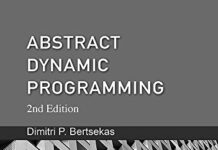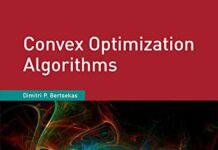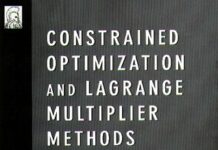
Ebook Info
- Published:
- Number of pages:
- Format: PDF
- File Size: 17.37 MB
- Authors: Dimitri P. Bertsekas
Description
crs7
User’s Reviews
Reviews from Amazon users which were colected at the time this book was published on the website:
⭐I have used this book and the OCW course for some months now for self study. There are certainly several things to like here:- Consistent and unambiguous notation, few typos, all the mathematics is done very neatly.- Great selection and sequencing of the subjects.- Broad coverage, several concepts which are very useful for problem solving but not emphasized by other books enough like conditioning are full developed here.- Lots and lots of examples (perhaps even too many, as it seems to have come at the expense of finding better explanations for things)- Huge number of problems of varying difficulty, including most of the classic ones (Two envelopes, Gamblers ruin, St. Petersburg, Monty Hall, etc.)Where the book falls short is providing a continuous narrative that would spark any kind of interest in the subject. Concepts are often introduced out of the blue sky, a few examples are shown, and the next part of material proceeds. Excellent example is the section on the normal distribution – formula for it is introduced, some example problems are solved, significant time is spent discussing the use of the tabulated distribution (I would prefer a link to Wolfram Alpha, is there anything particularly noble about using a table instead?) and that’s about it, there is not enough motivation that would help with recognizing the concepts in real world settings.Throughout the book you do learn to apply the concepts and theorems, probably enough to solve some textbook problems, but there is too little discussion to develop a deeper understanding. History of the subject is almost completely exempt from the book, so are the so called “philosophical” issues (actually as most will admit of crucial importance in practical applications), and the “applied” examples often feel contrived (“random variable X” is said to be a “signal intensity”, but there is not much more to it) or simply uninteresting, while so many great elementary yet non-trivial examples are to be found among real applications (in machine learning, probabilistic algorithms, information theory, coding theory, econometrics, …). Neither connections to other areas of mathematics get much explored. The exception are the end of chapter exercises, where some more interesting examples and concepts appear.I am reading in parallel Hamming’s “The Art of Probability”, a book that strongly emphasizes everything that this book omits, but to be fair is also nowhere near as throughout or well-organized as this Bertsekas/Tsitsiklis book. It’s funny however that Hamming’s book, from 1994, is way more informed by the invention of the computer than this book from 2008, including discussion of simulation, coding theory, numerical issues etc. Hamming also derives the Normal distribution starting from a real world problem, and not just presents the formula. I do hope the authors will publish a third edition that keeps the many advantages of this book but addresses those deficiencies. Meanwhile, I do recommend this book, but I also recommend supplementing it with another one that motivates the subject better, like the book by Hamming.
⭐If you want to learn probability outside of a physical classroom, this book is an excellent choice. Detailed solutions for all end of chapter problems are available for free from the publisher’s website. In addition, this book is used for MIT course 6.041, and MIT offers Open Courseware materials on their website for free. This includes videos of the lectures, as well as more solved problems (beyond those in the book itself) in the form of recitations, problem sets, tutorial problems, and past exams from the MIT class.There is also an edX MOOC that uses this book, with a different set of lectures that are less abbreviated than those for the MIT course.The book itself does a good job of presenting many of the classic problems of probability, including the Monty Hall Problem, the Prisoner’s Dilemma, the Two Envelopes Paradox, and the St. Petersburg Paradox. Also, since this is used in the MIT electrical engineering and computer science department, there are problems throughout the book relating to subjects such as reliability and signal degradation.Finally, even though this book covers probability (not probability and statistics), it does cover the normal distribution throughout, as well as the Markov and Chebyshev Inequalities, the Central Limit Theorem, and the Law of Large Numbers. It also contains two chapters added in the 2nd edition covering statistical inference (Classical and Bayesian).
⭐As many here I have bought this book to take OCW on probability (which is good and free). The book covers a broad range of topics from elementary probability to statistics. As an additional plus, you can find s solution manual on the internet to check your solutions.Although I like this book, I do not think that the price is right. 90$ for a new and 55$ for a used one is a highway robbery. A couple of weeks ago I bought a used book on probability for just 1$ on friends of a local library sale which has all of the same topics and quite nice explanations. So, if you need a book on probability to brush/refresh your skills I would suggest you find something more affordable.
⭐Many say this is the best single text on introductory probability, and they have a strong case to say so. It is likely the most user-friendly text available on the subject. The material is explained in a conversational fashion, striking an excellent balance between intuition and mathematics – skewed more toward intuition, which is appropriate for an introductory treatment.You can click to read the table of contents for yourself, but I will single out chapters 6 and 7 as, at least my own favorites. In Chapter 6, the side by side treatment of the Bernoulli and Poisson processes is unique, which is surprising as this text makes this look like obviously the best way to treat them. Chapter 7 on Markov chains is more conventional, but still very good, and includes some material on continuous parameter chains – not always covered at this level.As a plus, Tsitsiklis has corresponding lecture videos online, both from MIT and on Coursera.I would supplement this text with Blitzstein’s “Introduction to Probability”, which treats the material with a very different slant, at perhaps a slightly deeper level in some cases, while still being introductory.
⭐stats need a teacher to explain all the concepts, the most useful thing about the book is it has all the equations you need in summarized boxes for quick study
⭐Dimitri has a great course online – superb teacher at MIT
⭐Best book on probability I’ve ever read. Very clear, excellent choice of topics, excellent balance between text and examples. Also used as the textbook in the graduate probability course at MIT taught by prof. Tsitsiklis (co-author) – fabulous course, by the way – , also available online at EdX.One suggestion for improvement: I always try to solve the examples before reading their solution. Yet several examples do not state the problem before solving it 🙂
⭐Il testo affianca le lezioni on line di probabilità del MIT ed è a mio parere il non plus ultra per chi voglia accostarsi con impegno e serietà a questo meraviglioso argomentoEl libro es muy bueno, y puede ser usado para complementar las clases de OCW del MIT en Probabilistic Systems and Applied Probability.Sin embargo tenía páginas rotas, y en malas condiciones.Exceptional good book, very well written, and the questions at the end of the chapter are real life examples and quite challenging. Highly recommended to be read in parallel with the MIT course.
Keywords
Free Download Introduction To Probability 2nd Edition in PDF format
Introduction To Probability 2nd Edition PDF Free Download
Download Introduction To Probability 2nd Edition PDF Free
Introduction To Probability 2nd Edition PDF Free Download
Download Introduction To Probability 2nd Edition PDF
Free Download Ebook Introduction To Probability 2nd Edition



